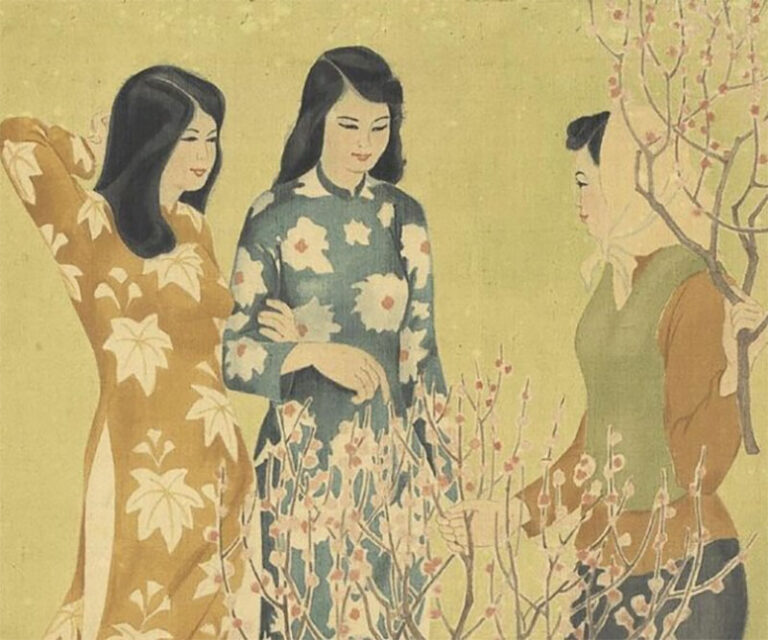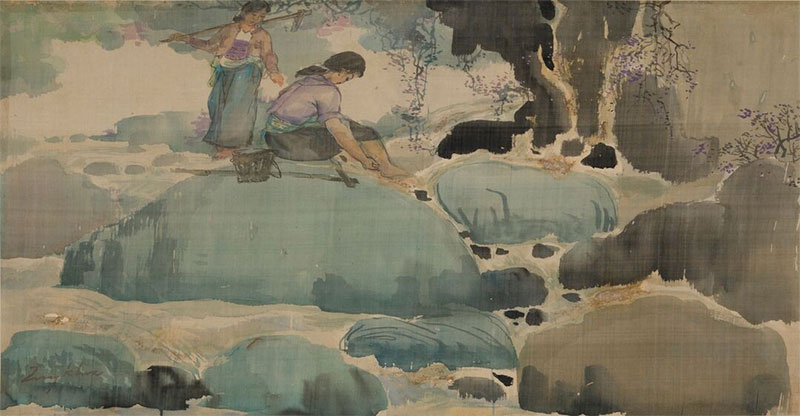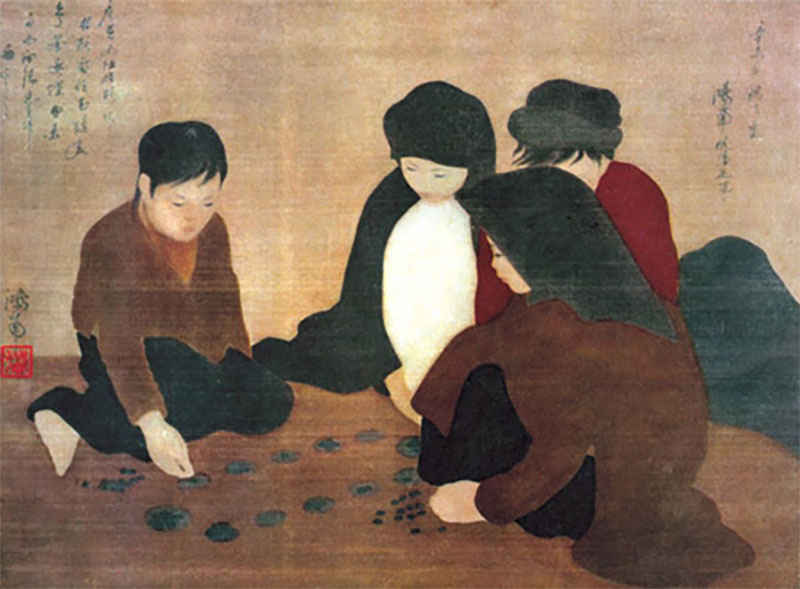
Vietnamese silk painting is one of the unique traditional art forms in Vietnam. Along with the development of modern Vietnamese Art, silk paintings have gone through many stages with changes in content and painting techniques. In addition, modern silk paintings have made many advances in handling light and color. Each painting is an incredible masterpiece of beautiful nature and people, showing Vietnamese artists’ talent, creativity, and ingenuity.
Contents
Origin of Vietnamese Silk Paintings
Silk paintings are often mentioned in some Eastern countries with sericulture, such as Japan, China, and Vietnam. Silk paintings have appeared in Vietnam for a long time. At that time, people or artists did not make silk paintings using any process or technique. It is just an acquisition of experience from one generation to the next. However, the ancient artisans left behind a precious heritage with national identity, which is the foundation for the development of silk painting. The Vietnam History Museum has some famous silk paintings, such as portrait paintings of Nguyen Trai and Phung Khac Hoan (XV-XVI centuries).
The art of silk painting in Vietnam reached its peak of success in the 1930s. In 1925, the Indochina College of Fine Arts was founded in Hanoi by the French artist Victor Tardieu. Some artists from this school combined the painting of Western Art with Eastern aesthetics, bringing a new nuance to creativity and marking the development of silk painting.
The initial results in paving the way for Vietnamese silk paintings by Indochina College of Fine Arts students were recorded in a painting exhibition in 1931. Vietnamese silk paintings were introduced and displayed with public recognition. European audiences with famous works by Nguyen Phan Chanh, Nguyen Nam Phuong, and Ngoc Van.

Materials and Techniques Used in Silk Painting
Material
Regarding painting materials, painted silk is usually flawless, smooth, or slightly rough, handwoven, or machine-woven. Due to the requirements of the fine arts industry, textile factories have recently produced silk used explicitly for painting, thin and slightly sparse, with clearly visible silk fibers. The paint used to paint silk is usually watercolor, pigment, or grape ink. Many artists use opaque, thicker paints such as tempera, powder colors, pastels, etc., to try their hand at silk.
Colors painted on silk paintings
After silk substrate, color is also an indispensable material for silk painting. The colors used to paint silk are usually watercolors. In the past, colors were often made from natural products that were available and easy to find, such as black from bamboo charcoal, indigo green, and white from scallops, which are durable but less fresh than modern watercolor. Many artists use thicker and opaque colors such as paint, gouache, and pastel to test on silk. Regardless of the style, silk painters must have in-depth knowledge of the material and fully exploit its shine and appeal.
The color used in silk paintings is also essential to clearly express the beauty that the artist wants to convey. In the past, people used water, food coloring, grape ink, or natural products such as indigo leaves, bamboo leaves, rose water, and wine wood. Nowadays, with the development of technology and the requirements for Vietnamese silk painting being more advanced, artists use more powder colors, pastels, tempera, etc.
The strength of silk painting is in the clarity and softness of the colors, so most silk painters often create sketches (images, arrays) very carefully before displaying them on silk. Many people use tracing images from paper onto silk to save the outline accurately. However, you can also paint silk comfortably.
Technique
Regarding silk painting techniques, the most extraordinary point between old and modern silk painting techniques in Vietnam is that old silk paintings are often painted directly on dry silk. In contrast, modern silk paintings are dyed over and over again. Color on silk surface.
When painting silk, people often paint from light to dark. Light colors overlapping often will become dark, but the silk fibers can still be seen, creating the beauty of silk. Painting on each other with different colors is also a way of mixing colors. Occasionally, when the color has dried, gently wash off any dirt that floats on the surface of the silk and let the color soak into each fiber of the silk.
Before painting, the silk must be stretched to the wooden frame. The frame does not need to be as thick and robust as those used for oil painting, as silk is delicate and does not need to be stretched. Most silk painters often sketch carefully before displaying their work on silk. Artists often paint from light to dark colors and use many layers of color to create the hidden beauty behind a silk painting. By using contemporary colors, Vietnamese silk paintings have a mysterious beauty because of their softness, sophistication, style, and versatility.
To make the adjacent color patches blend without any distinct boundaries, creating a soft, blurry effect, people paint while the silk surface is still slightly damp, and edging is unnecessary. We can also add scallion powder and silver to silk paintings (pasted on the back). Finished silk paintings are usually placed on a layer of paper. After completely drying, the artist can cut the painting out of the silk frame to put it in the frame. Silk paintings increase the aesthetic effect when used with glass frames.
Famous silk painting steps today
Completing a silk wall painting is highly meticulous and goes through many stages. Only artists who are genuinely passionate about this art can perform them. Old silk paintings were painted directly on dry fabric, but modern silk paintings use the technique of dyeing over and over again.
The painting process is as follows: First, the artist stretches the canvas on a wooden frame so that the canvas is not wrinkled or misaligned. Next is the stage of starching the silk with a mixture of rice flour and alum to keep the color of the silk longer. The artist started sketching with a thin pencil and then added color based on the inspiration. At this point, the artist dyes each layer of silk so that the color penetrates each fiber. The colors overlap from light to dark. Not stopping there, if stains or lumps appear on the surface, the artist must gently wash them to remove them. That said, the process of making a silk painting is very meticulous.
Expressive Value of Vietnamese Silk Paintings
Silk is a light, thin material, so artists rarely use floating blocks of natural space or rarely use light like oil paint. They create their own separate space without relying on any perspective, just like the famous artist Nguyen Phan Chanh did in his silk artwork “Choi O An Quan“, the painting only focuses on describing four little girls and mandarin dining boxes, or the painting “Washing vegetables on a pond bridge” which only has an image of a girl with a basket of vegetables, a basin of water and a pond bridge. Clear or blurred drawings in silk paintings are handled in a reasonable relationship depending on the author’s perspective and sense. Therefore, a silk painting can be enjoyed from afar or up close.
Each material used to paint will have a different shade, contributing to the “soul” of each work. Silk is inherently a soft, fragile material that highlights the painting’s subject and spatial dimensions. For example, in the work “Dream” by artist Hoang Ngoc Ha, the silk material expresses the girl’s gentleness in the painting.
Thanks to silk painting, Vietnamese art has been promoted worldwide because it is on par with silk paintings from other countries, including China and Japan. Silk painting themes include people’s daily lives, portraits, history, or landscapes displayed in several painting exhibitions in Vietnam and abroad since 2006. At this exhibition, we can see that the art of silk painting is still preserved and promoted as an essential and indispensable part of Vietnamese painting art.
Nowadays, interior decoration with silk wall paintings is trendy. Wall paintings with bold traditional features are suitable for ancient spaces. For spaces with intricate lines, wall paintings with soft beauty will help make the interior more sophisticated.

Typical Vietnamese silk painters and their contributions
- Artist Nguyen Phan Chanh: He plays a vital role in promoting and popularizing silk painting as a recognized form of painting art in Vietnam. “The Buskers”, “The Meal” and “The Dress Stitchers” are some of his most notable creations.
- Artist Nguyen Gia Tri: A famous artist in the early period of silk painting in Vietnam. His silk paintings were displayed at the first National Fine Arts Exhibition held at the Hanoi Opera House.
- Artist Luong Xuan Nhi: is a Vietnamese artist worth mentioning; his silk pieces are famous for their natural colors. His two most beautiful paintings are “Fisherman’s Family” and “Embroiderers”.
- Artist To Ngoc Van: This is one of the famous painters of Vietnamese silk paintings later. He layered bold, broad strokes over a light background, giving the silk painting a new sense of freedom. Some of his most famous works are “Noon”, “The Young Lady with the Lily” and “The Two Young Women and the Baby”.